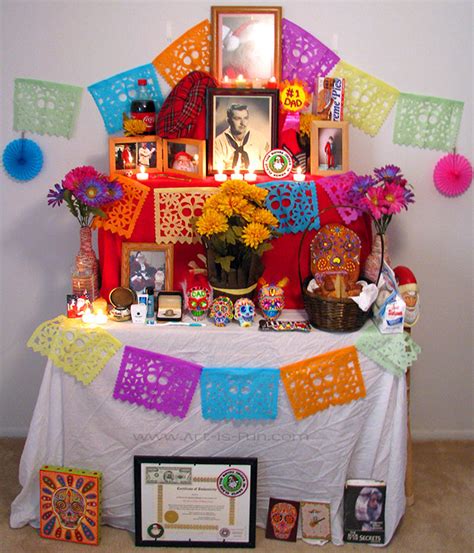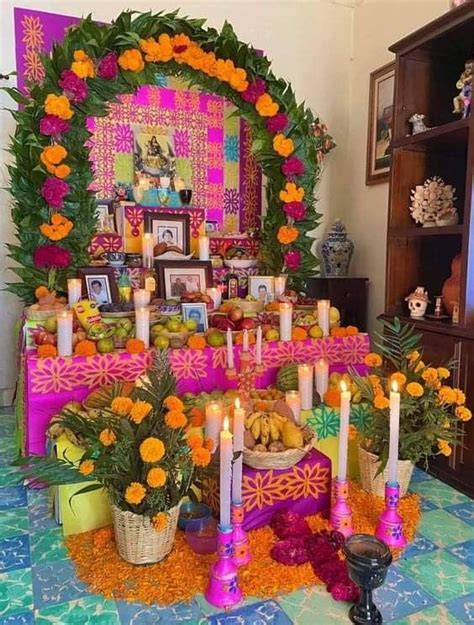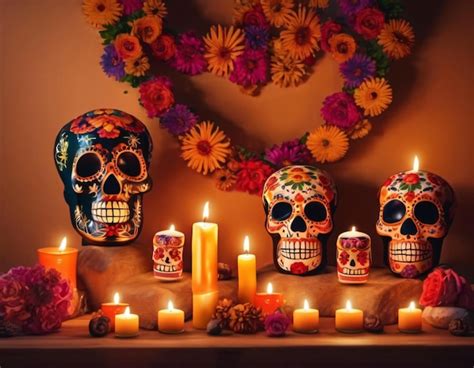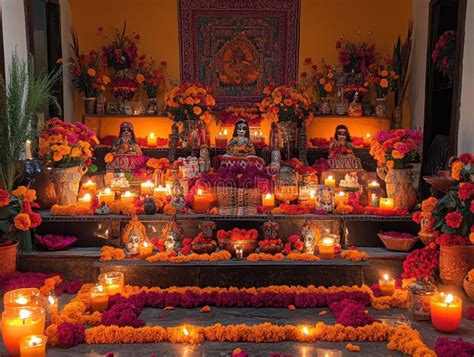In the spirit of honoring the dearly departed, the creation of an ofrenda, or traditional altar, is a significant aspect of various cultural practices, most notably in the Mexican celebration of Día de los Muertos (Day of the Dead). This elaborate and meaningful structure is designed to welcome the spirits of loved ones back into the world of the living, if only for a brief period. The ofrenda is a vibrant display of love, respect, and remembrance, adorned with a myriad of items that hold personal and symbolic significance.
To create an ofrenda that truly captures the essence of this tradition, one must delve into the rich cultural heritage and symbolism that underpin this practice. The process begins with a deep understanding of the components that make up the altar and the roles they play in honoring the deceased. Each element, from the photographs of the departed to the offerings of food, drink, and personal items, is meticulously chosen to ensure a warm and welcoming environment for the returning spirits.
Historical Evolution of the Ofrenda
The origins of the ofrenda can be traced back to the indigenous cultures of Mexico, where the belief in an afterlife and the importance of ancestors were deeply ingrained. Over time, with the influence of Catholicism and other external factors, the tradition evolved, incorporating new elements while retaining its core essence. Today, the ofrenda is a testament to the blending of cultures, a unique blend of pre-Hispanic and European traditions.
Structuring Your Ofrenda: A Step-by-Step Guide
Choosing the Location: The first step in creating your ofrenda is selecting a suitable location. Ideally, this should be a quiet, respectful area of your home where the altar can remain undisturbed. Consider the flow of traffic and the ease of viewing the ofrenda from different angles.
Selecting a Base: The foundation of your ofrenda can vary, from a simple table or shelf to a more elaborate structure. The key is to ensure it is sturdy and can support the weight of the offerings and decorations.
Layering the Ofrenda: Traditionally, an ofrenda is layered, with each level representing a different aspect of the journey between the world of the dead and the world of the living. The bottom layer often includes items like papel picado (tissue paper banners), which symbolize the wind, and a pathway of marigold petals or ash leading to the ofrenda, guiding the spirits.
Including Personal Items: Personal items that belonged to the deceased or hold sentimental value are crucial. This can range from clothing and jewelry to personal mementos and favorite objects. These items help to create a personal connection and invite the spirit to feel welcomed and remembered.
Food and Drink Offerings: A significant component of the ofrenda is the offering of food and drink. Traditional items include pan de muerto (a sweet bread), moles, tamales, fruits, and the favorite foods and beverages of the deceased. The belief is that the spirits consume the essence of these offerings, nourishing them on their journey.
Photographs and Mementos: Placing photographs of the deceased on the ofrenda serves as a direct invitation for them to return. Alongside these, include any mementos or small tokens that represent significant events, relationships, or characteristics of the deceased.
Candles and Incense: Candles, particularly those in the colors of the marigold (orange, yellow) and copal incense, are used to light the way for the spirits and to purify the area, creating a sacred space.
Flowers and Greenery: Marigolds and baby’s breath are traditionally used to adorn the ofrenda. These flowers are believed to attract the spirits with their strong scent and vibrant colors.
Cultural Significance and Symbolism
Each element of the ofrenda carries deep cultural significance and symbolism, reflecting the beliefs and values of the communities that create them. The act of building an ofrenda is not merely a decorative exercise but a profound expression of love, respect, and the belief in the continued presence of the deceased in the lives of the living.
Expert Insights: Honoring Ancestors
According to Dr. María Herrera-Sobek, a renowned scholar in Chicana/o Studies, “The ofrenda represents a portal between the world of the living and the dead, a space where the boundaries between the two are blurred, allowing for a temporary reunion between the deceased and their loved ones.” This perspective underscores the ofrenda’s role in maintaining familial and communal bonds that transcend mortality.
Thought Experiment: Connecting with the Past
Imagine walking into a room filled with the memories of your ancestors. Each item on the ofrenda tells a story, evokes a memory, or symbolizes a belief. As you breathe in the scent of copal and marigolds, you feel a deep connection to those who have come before you. This exercise in empathy and remembrance is at the heart of the ofrenda tradition, bridging the gap between past and present.
Future Trends: Evolution of the Ofrenda Tradition
As cultures evolve and societies become more global, the tradition of the ofrenda is also undergoing changes. Incorporations of new technologies, eco-friendly materials, and cross-cultural exchange are enriching the practice, ensuring its relevance and vibrancy for future generations.
Practical Application: Creating Your Own Ofrenda
Creating your own ofrenda is a deeply personal and fulfilling experience. Start by gathering items that hold personal significance and symbolize your connection to the deceased. Consider the colors, scents, and textures that evoke memories and emotions. As you lay out each item, reflect on its significance and the story it tells. The ofrenda is a living, breathing entity that grows with each addition, telling a story of love, loss, and remembrance.
Decision Framework: Choosing the Right Elements
When deciding which elements to include in your ofrenda, consider the following criteria: - Personal Significance: Does the item hold personal significance or sentimental value? - Cultural Relevance: Is the item relevant to the cultural tradition of the ofrenda? - Symbolic Meaning: Does the item carry symbolic meaning or represent a particular aspect of the deceased’s life or personality? - Aesthetic Appeal: Does the item contribute to the overall aesthetic of the ofrenda, enhancing its visual and emotional impact?
Step-by-Step Guide to Building an Ofrenda
Step 1: Prepare the Space

Clear the area where the ofrenda will be placed, ensuring it is free from clutter and distractions. This space should be dedicated solely to the ofrenda.
Step 2: Lay the Foundation

Place the base or tablecloth that will serve as the foundation of the ofrenda. This can be adorned with papel picado or other decorative elements.
Step 3: Add the First Layer
This layer typically includes items like photographs, personal mementos, and the favorite foods and drinks of the deceased.
Step 4: Incorporate Symbols and Offerings
Add symbols of the afterlife, such as marigolds, copal incense, and candles. These items are believed to guide the spirits and create a welcoming environment.
Step 5: Final Touches

Complete the ofrenda by adding any final decorations or personal touches. This could include additional flowers, ribbons, or other meaningful items.
FAQ Section
What is the significance of marigolds in the ofrenda tradition?
+Marigolds are used to attract the spirits with their strong scent and vibrant colors, symbolizing the sun and the cycle of life and death.
How do I choose the right items for my ofrenda?
+Choose items that hold personal significance, are culturally relevant, carry symbolic meaning, and contribute to the aesthetic appeal of the ofrenda.
Can I include items that are not traditionally part of the ofrenda?
+Yes, the ofrenda is a personal and evolving tradition. Including items that hold personal significance to you or the deceased is encouraged, as long as they are done with respect and thoughtfulness.
In conclusion, the creation of an ofrenda is a profound act of love and remembrance, a bridge between the worlds of the living and the dead. Through its construction, we honor our ancestors, celebrate their lives, and reaffirm the bonds that connect us across generations. As we build our ofrendas, we not only pay tribute to those who have come before us but also ensure the continuation of a vibrant cultural tradition, one that fills our lives with meaning, beauty, and the enduring presence of love.


